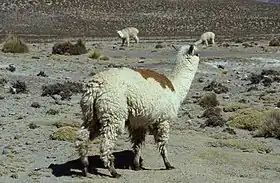
Huacaya is one of the two breeds that make up the species Lama pacos, commonly known as the alpaca (the other breed is the Suri).[1] It lives on the Altiplano in the Andes, up to 4,000 metres (13,000 ft) above sea level. Its natural range encompasses four South American countries.
Phenotype characteristics
Both breeds are easily identifiable by their phenotypic characteristics.[1] There are no differences in weight, or pup at birth (7.5–8 kilograms (17–18 lb)) or the adult specimens, weighing about 70 kilograms (150 lb) in males and 65 kilograms (143 lb) in females.[2]

Animals of the Huacaya breed of alpacas have a rounded and bulky bodies. Huacaya fiber grows perpendicular to the body of the alpaca, and is bulky, smooth and dense. Its curls in its sponge-like fibre are shorter and duller compared with Suri, with an absence of wool grease that is characteristic of Corriedale sheep.[1] Both alpaca breeds possess a vast array of coat colors, totalling 22 different varieties.
Population
Huacayas far outnumber the Suri population. In Chile, all alpacas are of the Huacaya type, and there is a negligible amount of Suri specimens in Bolivia at the northern border. Peru, which contains the majority of the world's alpaca, has 93% Huacaya as estimated by the Food and Agriculture Organization.[3] Thus of the 3.7 million animals worldwide, more than 90% are thought to be of the Huacaya breed.[4]
Products
Fibre
Huayaca fiber is made up of between 150–170 threads per mm2.[5][6] At 25 μm (0.00098 in) thick, their fiber is 1.5 μm (5.9×10−5 in) thinner than that of the Suri, and considerably whiter, on average. Suri fiber is marginally stronger[4] Some of the products that can be made with fine Huacaya fiber include:
Meat
While huayacas were never bred for meat, their meat is a useful perfectly edible by-product and very high in protein. The carcass weight varies at around 50% of live weight and 23 kilogrammes.[7] Huacaya are thought to produce more meat than the Suri.[8] Alpaca meat has a high protein to fat ratio, with the most common breed containing on average 23% protein.[7]
References
- 1 2 3 Manna, V. La; Terza, A. La; Dharaneedharan, S.; Ghezzi, S.; Saravanaperumal, S. Arumugam; Apaza, N.; Huanca, T.; Bozzi, R.; Renieri, C. (2011-01-01). Pérez-Cabal, Ma Ángeles; Gutiérrez, Juan Pablo; Cervantes, Isabel; Alcalde, Ma Jesús (eds.). A microsatellite study on the genetic distance between Suri and Huacaya phenotypes in Peruvian alpaca (Vicugna pacos). Wageningen Academic Publishers. p. 1. doi:10.3920/978-90-8686-727-1_20. ISBN 978-90-8686-727-1.
- ↑ Fernández-Baca, Sr. Saúl (2005). SITUACIÓN ACTUAL DE LOS CAMÉLIDOS SUDAMERICANOS EN PERÚ (PDF) (in Spanish). Food and Agriculture Organisation of the United Nations. p. 13. Regional TCP project TCP/RLA/2914.
- ↑ Quispe, E.c.; Rodríguez, T.c.; Iñiguez, L.r.; Mueller, J.p. (2009-10-01). "Producción de fibra de alpaca, llama, vicuña y guanaco en Sudamérica". Animal Genetic Resources Information. 45: 1–14. doi:10.1017/S1014233909990277. ISSN 2078-6344.
- 1 2 Atav, Rıza; Türkmen, Fatih (2015-08-01). "Investigation of the dyeing characteristics of alpaca fibers (Huacaya and Suri) in comparison with wool" (PDF). Textile Research Journal. 85 (13): 1331–1339. doi:10.1177/0040517514563727. ISSN 0040-5175. S2CID 138553639. Archived from the original (PDF) on 2016-02-25.
- ↑ Maccagno, Luis. (1912) La raza de alpaca Suri. Anales de la Dirección de Fomento de Lima (Perú), Números 7-12.
- ↑ Romero, Elías C. (1927) Llamas, alpacas, vicuñas y guanacos. Imp. F. Gurfinkel. 203 páginas.
- 1 2 Salvá, Bettit K.; Zumalacárregui, José M.; Figueira, Ana C.; Osorio, María T.; Mateo, Javier (2009-08-01). "Nutrient composition and technological quality of meat from alpacas reared in Peru". Meat Science. 82 (4): 450–455. doi:10.1016/j.meatsci.2009.02.015. PMID 20416683.
- ↑ Huarachi, David. Manual cría de camélidos sudamericanos. Ediciones Kollu Huma. 54 páginas.